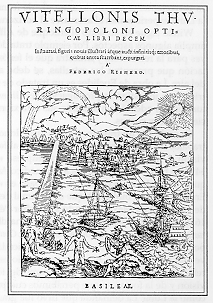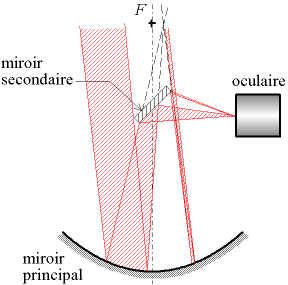
Vitello (Polish : Witelon; German : Witelo; c. 1230 – 1280/1314) was a Polish friar, theologian, natural philosopher and an important figure in the history of philosophy in Poland.

Vitello (Polish : Witelon; German : Witelo; c. 1230 – 1280/1314) was a Polish friar, theologian, natural philosopher and an important figure in the history of philosophy in Poland.
Vitello's name varies with some sources. In earlier publications he was quoted as Erazmus Ciolek Witelo, Erazm Ciołek, Vitellio and Vitulon. Today, he is usually referred to by his Latin name Vitello Thuringopolonis, often shortened to Vitello.
Vitello's exact birth-name and birthplace are uncertain. He was most likely born around 1230 in Silesia, in the vicinity of Legnica. [1] His mother came from a Polish knightly house, while his father was a German settler from Thuringia. He called himself, in Latin, "Thuringorum et Polonorum filius" — "a son of Thuringians and Poles." He studied at Padua University about 1260, then went on to Viterbo. He became friends with William of Moerbeke, the translator of Aristotle from Greek language into Latin. Vitello's major surviving work on optics, Perspectiva, completed in about 1270–78, [2] was dedicated to William. In 1284 he described the reflection and refraction of light. [3]

Vitello's Perspectiva was largely based on the work of the polymath Alhazen (Ibn al-Haytham; d. ca. 1041) and Robert Grosseteste, and he in turn influenced later scientists, in particular Johannes Kepler. Vitello's treatise in optics was closely linked to the Latin version of Ibn al-Haytham's Arabic opus: Kitab al-Manazir (The Book of Optics; De aspectibus or Perspectivae), and both were printed in the Friedrich Risner edition Opticae thesaurus (Basel, 1572). [4]
Vitello's Perspectiva, which rested on Ibn al-Haytham's research in optics, influenced also the Renaissance theories of perspective. Lorenzo Ghiberti's Commentario terzo (Third Commentary) was based on an Italian translation of Vitello's Latin Perspectiva. [5]
Vitello's treatise also contains much material in psychology, outlining views that are close to modern notions on the association of ideas and on the subconscious.
Perspectiva also includes Platonic metaphysical discussions. Vitello argues that there are intellectual and corporeal bodies, connected by causality (corresponding to the Idealist doctrine of the universal and the actual), emanating from God in the form of Divine Light. Light itself is, for Vitello, the first of all sensible entities, and his views on light are similar to those held by Roger Bacon, though he is closer in this to Alhazen's legacy. [6]
In Perspectiva, Vitello refers to other works that he had written. Most of these do not survive, but De natura daemonum and De primaria causa paenitentiae have been recovered.
The lunar crater Vitello is named after him.

Ḥasan Ibn al-Haytham was a medieval mathematician, astronomer, and physicist of the Islamic Golden Age from present-day Iraq. Referred to as "the father of modern optics", he made significant contributions to the principles of optics and visual perception in particular. His most influential work is titled Kitāb al-Manāẓir, written during 1011–1021, which survived in a Latin edition. The works of Alhazen were frequently cited during the scientific revolution by Isaac Newton, Johannes Kepler, Christiaan Huygens, and Galileo Galilei.

A camera obscura is the natural phenomenon in which the rays of light passing through a small hole into a dark space form an image where they strike a surface, resulting in an inverted and reversed projection of the view outside.

Islamic philosophy is philosophy that emerges from the Islamic tradition. Two terms traditionally used in the Islamic world are sometimes translated as philosophy—falsafa, which refers to philosophy as well as logic, mathematics, and physics; and Kalam, which refers to a rationalist form of Scholastic Islamic theology which includes the schools of Maturidiyah, Ashaira and Mu'tazila.
Early Islamic philosophy or classical Islamic philosophy is a period of intense philosophical development beginning in the 2nd century AH of the Islamic calendar and lasting until the 6th century AH. The period is known as the Islamic Golden Age, and the achievements of this period had a crucial influence in the development of modern philosophy and science. For Renaissance Europe, "Muslim maritime, agricultural, and technological innovations, as well as much East Asian technology via the Muslim world, made their way to western Europe in one of the largest technology transfers in world history." This period starts with al-Kindi in the 9th century and ends with Averroes at the end of 12th century. The death of Averroes effectively marks the end of a particular discipline of Islamic philosophy usually called the Peripatetic Arabic School, and philosophical activity declined significantly in Western Islamic countries, namely in Islamic Spain and North Africa, though it persisted for much longer in the Eastern countries, in particular Persia and India where several schools of philosophy continued to flourish: Avicennism, Illuminationist philosophy, Mystical philosophy, and Transcendent theosophy.

Science in the medieval Islamic world was the science developed and practised during the Islamic Golden Age under the Abbasid Caliphate of Baghdad, the Umayyads of Córdoba, the Abbadids of Seville, the Samanids, the Ziyarids and the Buyids in Persia and beyond, spanning the period roughly between 786 and 1258. Islamic scientific achievements encompassed a wide range of subject areas, especially astronomy, mathematics, and medicine. Other subjects of scientific inquiry included alchemy and chemistry, botany and agronomy, geography and cartography, ophthalmology, pharmacology, physics, and zoology.
William of Moerbeke, O.P., was a prolific medieval translator of philosophical, medical, and scientific texts from Greek into Latin, enabled by the period of Latin rule of the Byzantine Empire. His translations were influential in his day, when few competing translations were available, and are still respected by modern scholars.

Girard Desargues was a French mathematician and engineer, who is considered one of the founders of projective geometry. Desargues' theorem, the Desargues graph, and the crater Desargues on the Moon are named in his honour.

Kamal al-Din Hasan ibn Ali ibn Hasan al-Farisi or Abu Hasan Muhammad ibn Hasan ) was a Persian Muslim scientist. He made two major contributions to science, one on optics, the other on number theory. Farisi was a pupil of the astronomer and mathematician Qutb al-Din al-Shirazi, who in turn was a pupil of Nasir al-Din Tusi.

Catoptrics deals with the phenomena of reflected light and image-forming optical systems using mirrors. A catoptric system is also called a catopter (catoptre).

Optics began with the development of lenses by the ancient Egyptians and Mesopotamians, followed by theories on light and vision developed by ancient Greek philosophers, and the development of geometrical optics in the Greco-Roman world. The word optics is derived from the Greek term τα ὀπτικά meaning 'appearance, look'. Optics was significantly reformed by the developments in the medieval Islamic world, such as the beginnings of physical and physiological optics, and then significantly advanced in early modern Europe, where diffractive optics began. These earlier studies on optics are now known as "classical optics". The term "modern optics" refers to areas of optical research that largely developed in the 20th century, such as wave optics and quantum optics.

Latin translations of the 12th century were spurred by a major search by European scholars for new learning unavailable in western Europe at the time; their search led them to areas of southern Europe, particularly in central Spain and Sicily, which recently had come under Christian rule following their reconquest in the late 11th century. These areas had been under Muslim rule for a considerable time, and still had substantial Arabic-speaking populations to support their search. The combination of this accumulated knowledge and the substantial numbers of Arabic-speaking scholars there made these areas intellectually attractive, as well as culturally and politically accessible to Latin scholars. A typical story is that of Gerard of Cremona, who is said to have made his way to Toledo, well after its reconquest by Christians in 1085, because he:
arrived at a knowledge of each part of [philosophy] according to the study of the Latins, nevertheless, because of his love for the Almagest, which he did not find at all amongst the Latins, he made his way to Toledo, where seeing an abundance of books in Arabic on every subject, and pitying the poverty he had experienced among the Latins concerning these subjects, out of his desire to translate he thoroughly learnt the Arabic language.
Abdelhamid Ibrahim Sabra (1924-2013) was a professor of the history of science specializing in the history of optics and science in medieval Islam. He died December 18, 2013. Sabra provided English translation and commentary for Books I-III of Ibn al-Haytham's seven book Kitab al-Manazir, written in Arabic in the 11th century.

Friedrich Risner was a German mathematician from Hersfeld, Hesse. He was an assistant to Petrus Ramus and was the first chair of mathematics at Collège Royale de France (1576).

The Book of Optics is a seven-volume treatise on optics and other fields of study composed by the medieval Arab scholar Ibn al-Haytham, known in the West as Alhazen or Alhacen.

During the High Middle Ages, the Islamic world was an important contributor to the global cultural scene, innovating and supplying information and ideas to Europe, via Al-Andalus, Sicily and the Crusader kingdoms in the Levant. These included Latin translations of the Greek Classics and of Arabic texts in astronomy, mathematics, science, and medicine. Translation of Arabic philosophical texts into Latin "led to the transformation of almost all philosophical disciplines in the medieval Latin world", with a particularly strong influence of Muslim philosophers being felt in natural philosophy, psychology and metaphysics. Other contributions included technological and scientific innovations via the Silk Road, including Chinese inventions such as paper, compass and gunpowder.
Nader El-Bizri served as the Dean of the College of Arts, Humanities, and Social Sciences at the University of Sharjah. He was before that a tenured longstanding full Professor of philosophy and civilization studies at the American University of Beirut, where he also acted as an Associate Dean of the Faculty of Arts and Sciences, and as the Director of the General Education program. El-Bizri specializes in phenomenology, Islamic science and philosophy, and architectural theory. He is the author or editor of several books, including The Phenomenological Quest between Avicenna and Heidegger (2000).
The natural sciences saw various advancements during the Golden Age of Islam, adding a number of innovations to the Transmission of the Classics. During this period, Islamic theology was encouraging of thinkers to find knowledge. Thinkers from this period included Al-Farabi, Abu Bishr Matta, Ibn Sina, al-Hassan Ibn al-Haytham and Ibn Bajjah. These works and the important commentaries on them were the wellspring of science during the medieval period. They were translated into Arabic, the lingua franca of this period.
The history of experimental research is long and varied. Indeed, the definition of an experiment itself has changed in responses to changing norms and practices within particular fields of study. This article documents the history and development of experimental research from its origins in Galileo's study of gravity into the diversely applied method in use today.

Ptolemy's Optics is a 2nd-century book on geometrical optics, dealing with reflection, refraction, and colour. The book was most likely written late in Ptolemy's life, after the Almagest, during the 160s. The work is of great importance in the early history of optics. The Greek text has been lost completely. Fragments of the work survive only in the form of a Latin translation, prepared around 1154 by Eugene of Palermo, based on an Arabic translation which was presumably based on the Greek original. Both the Arabic and the Greek texts are lost entirely, and the Latin text is "badly mangled". The Latin text was edited by Albert Lejeune in 1956. The 1996 English translation by Mark Smith is based on Lejeune's Latin text.
Sabetai Unguru was an Israeli historian of mathematics and science.
Vitello and his thoughts
Studies